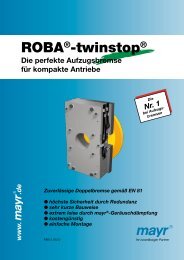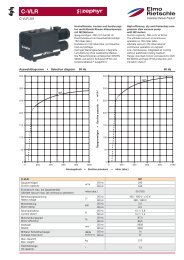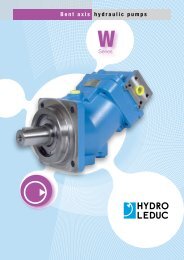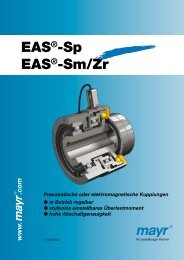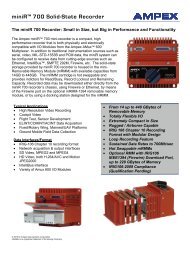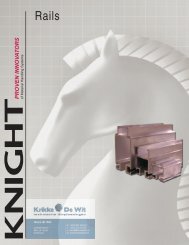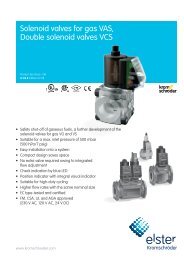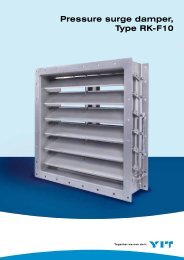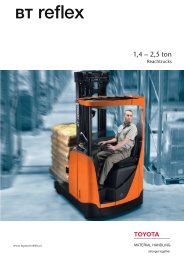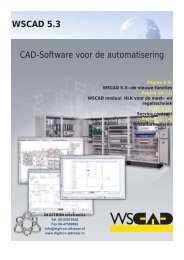CENTAX®-SEC - Industrial and Bearing Supplies
CENTAX®-SEC - Industrial and Bearing Supplies
CENTAX®-SEC - Industrial and Bearing Supplies
Sie wollen auch ein ePaper? Erhöhen Sie die Reichweite Ihrer Titel.
YUMPU macht aus Druck-PDFs automatisch weboptimierte ePaper, die Google liebt.
Explanation of the<br />
technical data<br />
1. Size designation<br />
The size is a spontaneously selected number, which<br />
designates the nominal size of the rubber element.<br />
2. Rubber quality<br />
This figure approximately states the nominal shore<br />
hardness of the rubber element in Shore A. The nominal<br />
value <strong>and</strong> the effective value may deviate from<br />
this.<br />
3. Nominal torque<br />
The nominal torque of the coupling is the torque which<br />
can be transmitted continuously over the entire speed<br />
range, unless other operating conditions (e.g. high<br />
temperature or certain tough applications) dem<strong>and</strong> a<br />
reduction.<br />
The working torque T L<br />
which is to be transmitted<br />
continuously or over a prolonged period, must<br />
therefore be smaller or not more than equal to the<br />
nominal torque.<br />
Erläuterung der<br />
technischen Daten<br />
1. Baugröße<br />
Die Größe ist eine freigewählte Ziffer, welche die Nenngröße<br />
des Gummielementes bezeichnet.<br />
2. Gummiqualität<br />
Diese Ziffer gibt in etwa die nominelle Shorehärte des<br />
Gummielementes in Shore A an. Der Sollwert und der<br />
effektive Wert können davon abweichen.<br />
3. Nenndrehmoment<br />
Das Nenndrehmoment der Kupplung ist das Drehmoment,<br />
das im gesamten Drehzahlbereich dauernd<br />
übertragen werden kann, wenn nicht <strong>and</strong>ere Betriebsbedingungen,<br />
(z.B. hohe Umgebungstemperatur oder<br />
sonstige harte Bedingungen) eine Reduzierung erfordern.<br />
Das von der Kupplung ständig oder über einen längeren<br />
Zeitraum zu übertragende Lastdrehmoment T L<br />
muß also kleiner oder höchstens gleich dem Nenndrehmoment<br />
sein.<br />
T L<br />
= P n –·9550<br />
T L<br />
≤ T KN<br />
P<br />
n<br />
T L<br />
T KN<br />
= power to be transmitted in kW<br />
= number of revolutions per minute<br />
= torque to be transmitted<br />
= nominal torque of the coupling<br />
T L<br />
= P n –·9550<br />
T L<br />
≤ T KN<br />
P<br />
n<br />
T L<br />
T KN<br />
= zu übertragende Leistung in kW<br />
= Drehzahl pro Minute<br />
= zu übertragendes Lastdrehmoment<br />
= Nenndrehmoment der Kupplung<br />
4. Maximum torque<br />
This maximum torque T Kmax<br />
of the coupling may occur<br />
occasionally, totally up to 1000 times.<br />
For more frequent peaks (e.g. engaging of clutches)<br />
T Kmax1<br />
is relevant, which may occur up to 50000<br />
times.<br />
4. Maximaldrehmoment<br />
Dieses Maximaldrehmoment T Kmax<br />
darf gelegentlich<br />
bei transienten Vorgängen insgesamt bis zu 1.000 mal<br />
auftreten.<br />
Für häufige Momentspitzen (z.B. Schaltvorgänge), die<br />
bis zu 50.000 mal auftreten dürfen, gilt T Kmax1<br />
T Kmax1<br />
= 0.5 · T Kmax<br />
T Kmax1<br />
= 0.5 · T Kmax<br />
For very rare, extraordinary conditions, (e.g. short circuit,<br />
wrong synchronisation) T Kmax2<br />
is allowable.<br />
T Kmax2<br />
= 1.5 · T Kmax<br />
The maximum range for torsional vibrations from peak<br />
to peak is ΔT max<br />
(e.g. passing through resonances,<br />
stop manoevres).<br />
ΔT max<br />
= 0.6 · T Kmax<br />
Für ganz seltene, abnormale Betriebszustände (z.B.<br />
Kurzschluss, Fehlsynchronisation), gilt T Kmax2<br />
T Kmax2<br />
= 1.5 · T Kmax<br />
Maximaler Drehmomentbereich (Amplitude zwischen<br />
maximalem und minimalem Drehmoment; z.B. Resonanzdurchfahrten,<br />
Bremsmanöver, etc.), gilt ΔT max<br />
ΔT max<br />
= 0.6 · T Kmax<br />
Remark:<br />
It is anticipated, that those temporary peak torques do<br />
not create a substantial temperature rise in the flexible<br />
rubber element.<br />
Governor hunting is not considered as an acceptable<br />
working condition <strong>and</strong> it should be avoided.<br />
Anmerkung:<br />
Bei den beschriebenen instationären Vorgängen wird<br />
davon ausgegangen, dass keine wesentlichen Temperaturerhöhungen<br />
in den elastischen Elementen entstehen.<br />
Reglerinstabilitäten gehören nicht zu den zulässigen<br />
instationären Betriebszuständen und sollten vermieden<br />
werden.<br />
CX-<strong>SEC</strong>-app-1<br />
CATALOG CX-<strong>SEC</strong>-07-10



